Airbus A350 XWB
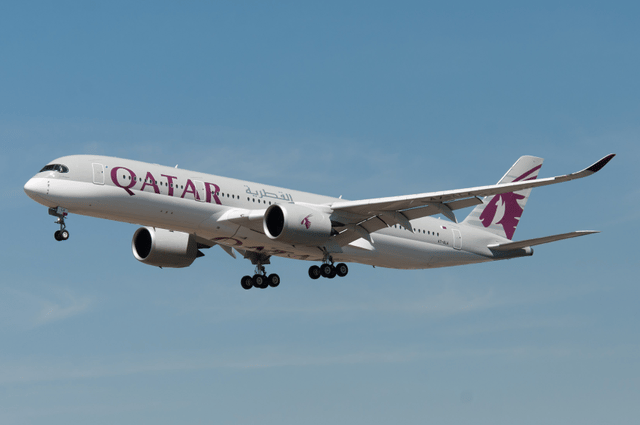
Airbus A350 XWB

| A350 XWB | |
|---|---|
| Qatar Airways was the A350-900 launch customer in December 2014. | |
| Role | Wide-body jet airliner |
| National origin | Multinational[5] |
| Manufacturer | Airbus |
| First flight | 14 June 2013[6] |
| Introduction | 15 January 2015 with Qatar Airways[7] |
| Status | In service |
| Primary users | Qatar Airways Singapore Airlines Cathay Pacific Lufthansa |
| Produced | 2010–present[8] |
| Number built | 300 as of 31 August 2019[9] |
| Program cost | €11 billion[10] |
| Unit cost | |
The Airbus A350 XWB is a family of long-range, twin-engine wide-body jet airliners developed by the European aerospace manufacturer Airbus. The A350 is the first Airbus aircraft with both fuselage and wing structures made primarily of carbon fibre reinforced polymer.[12] Its variants seat 315 to 369 passengers in typical seating layouts. The A350 is positioned to succeed the A340 and to compete with the Boeing 787 and 777.
The A350 was originally conceived in 2004 as a pairing of the A330's fuselage with new aerodynamics features and engines. In 2006, Airbus redesigned the aircraft in response to negative feedback from several major prospective customers, producing the "A350 XWB" (eXtra Wide Body). Development costs are estimated at €11 billion (US$15 billion or £9.5 billion). As of February 2019, Airbus had received 893 orders for A350s from 51 customers worldwide.[9] The prototype A350 first flew on 14 June 2013 from Toulouse, France. Type certification from the European Aviation Safety Agency was received in September 2014 and certification from the Federal Aviation Administration two months later. On 15 January 2015, the A350-900 entered service with its launch operator Qatar Airways; the A350-1000 did so on 24 February 2018 with the same airline.
| A350 XWB | |
|---|---|
| Qatar Airways was the A350-900 launch customer in December 2014. | |
| Role | Wide-body jet airliner |
| National origin | Multinational[5] |
| Manufacturer | Airbus |
| First flight | 14 June 2013[6] |
| Introduction | 15 January 2015 with Qatar Airways[7] |
| Status | In service |
| Primary users | Qatar Airways Singapore Airlines Cathay Pacific Lufthansa |
| Produced | 2010–present[8] |
| Number built | 300 as of 31 August 2019[9] |
| Program cost | €11 billion[10] |
| Unit cost | |
Development
Early designs
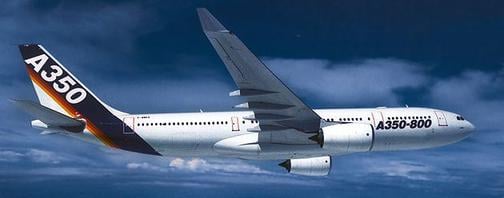
The initial A350 concept, based on the A330.
Airbus initially rejected Boeing's claim that the Boeing 787 Dreamliner would be a serious threat to the Airbus A330, stating that the 787 was just a reaction to the A330 and that no response was needed. When airlines urged Airbus to provide a competitor, Airbus initially proposed the "A330-200Lite", a derivative of the A330 featuring improved aerodynamics and engines similar to those on the 787.[13] The company planned to announce this version at the 2004 Farnborough Airshow, but did not proceed.[13]
On 16 September 2004, Airbus president and chief executive officer Noël Forgeard confirmed the consideration of a new project during a private meeting with prospective customers.[13] Forgeard did not give a project name, and he did not state whether it would be an entirely new design or a modification of an existing product. Airline dissatisfaction with this proposal motivated Airbus to commit €4 billion to a new airliner design.[13]
The original version of the A350 superficially resembled the A330 due to its common fuselage cross-section and assembly. A new wing, engines, and a horizontal stabiliser–to be coupled with new composite materials and production methods applied to the fuselage–would make the A350 an almost all-new aircraft.[13] On 10 December 2004, the boards of EADS and BAE Systems, then the shareholders of Airbus, gave Airbus an "authorisation to offer" (ATO) and formally named it the A350.[13][14][15]
On 13 June 2005 at the Paris Air Show, Middle Eastern carrier Qatar Airways announced that they had placed an order for 60 A350s. In September 2006 the airline signed a memorandum of understanding with General Electric to launch the GEnx-1A-72 engine for the aircraft.[16][17][18] Emirates sought a more improved design and decided against ordering the initial version of the A350.[19][20]
On 6 October 2005, the programme's industrial launch was announced with an estimated development cost of around €3.5 billion.[13] The A350 was initially planned to be a 250- to 300-seat twin-engine wide-body aircraft derived from the existing A330's design. Under this plan, the A350 would have modified wings and new engines while sharing the A330's fuselage cross-section. As a result of a controversial design, the fuselage was to consist primarily of aluminium-lithium rather than the carbon-fibre-reinforced polymer (CFRP) fuselage on the Boeing 787. The A350 would see entry in two versions: the A350-800 with a 8,800 nmi (16,300 km) range with a typical passenger capacity of 253 in a three-class configuration, and the A350-900 with 7,500 nmi (13,900 km) range and a 300-seat 3-class configuration. The A350 was designed to be a direct competitor to the Boeing 787-9 and 777-200ER.[13]
The A350 was publicly criticised by two of Airbus's largest customers, International Lease Finance Corporation (ILFC) and GE Capital Aviation Services (GECAS). On 28 March 2006, ILFC President Steven F. Udvar-Házy urged Airbus to pursue a clean-sheet design or risk losing market share to Boeing and branded Airbus's strategy as "a Band-aid reaction to the 787", a sentiment echoed by GECAS president Henry Hubschman.[21][22] In April 2006, while reviewing bids for the Boeing 787 and A350, CEO of Singapore Airlines (SIA) Chew Choon Seng, commented that "having gone through the trouble of designing a new wing, tail, cockpit... [Airbus] should have gone the whole hog and designed a new fuselage."[23]
Airbus responded that they were considering A350 improvements to satisfy customer demands. Airbus's then-CEO Gustav Humbert stated, "Our strategy isn't driven by the needs of the next one or two campaigns, but rather by a long-term view of the market and our ability to deliver on our promises."[24][25] As major airlines such as Qantas and Singapore Airlines selected the 787 over the A350, Humbert tasked an engineering team to produce new alternative designs.[26][27] One such proposal, known internally as "1d", formed the basis of the A350 redesign.[27]
Redesign and launch
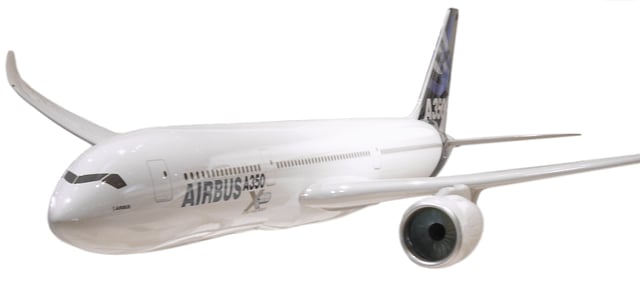
A model of the new design at ILA Berlin Air Show 2008.
The proposed A350 was a new design, including a wider fuselage cross-section, allowing seating arrangements ranging from an eight-abreast low-density premium economy layout to a ten-abreast high-density seating configuration for a maximum seating capacity of 440–475 depending on variant.[30][31] The A330 and previous iterations of the A350 would only be able to accommodate a maximum of eight seats per row. The 787 is typically configured for nine seats per row.[32] The 777 accommodates nine or ten seats per row, with more than half of recent 777s being ten-abreast as the 777X will be.[33] The A350 cabin is 12.7 cm (5.0 in) wider at the eye level of a seated passenger than the 787's cabin,[34] and 28 cm (11 in) narrower than the Boeing 777's cabin. (See Wide-body aircraft for a comparison of cabin widths and seating.) All A350 passenger models have a range of at least 8,000 nmi (14,816 km). The redesigned composite fuselage provides higher cabin pressure and humidity, and lower maintenance costs.
On 1 December 2006, the Airbus board of directors approved the industrial launch of the A350-800, -900, and -1000 variants.[35] The delayed launch decision was a result of delays of the Airbus A380[36] and discussions on how to fund development. EADS CEO Thomas Enders stated that the A350 programme was not a certainty, citing EADS/Airbus's stretched resources.[37][38] However, it was decided programme costs are to be borne mainly from cash-flow. First delivery for the A350-900 was scheduled for mid-2013, with the -800 and -1000 following on 12 and 24 months later, respectively.[35] New technical details of the A350 XWB were revealed at a press conference in December 2006. John Leahy indicated existing A350 contracts were being re-negotiated due to price increases compared to the original A350s contracted. On 4 January 2007, Pegasus Aviation Finance Company placed the first firm order for the A350 XWB with an order for two aircraft.[39]
The design change imposed a two-year delay into the original timetable and increased development costs from US$5.3 billion (€5.5 billion) to approximately US$10 billion (€9.7 billion).[40][41] The total development cost for the A350 was estimated at US$15 billion by Reuters (€12 billion or £10 billion).[42] The original mid-2013 delivery date of the A350 changed, as a longer than anticipated development forced Airbus to delay the final assembly and first flight of the aircraft to the third quarter of 2012 and second quarter of 2013 respectively. As a result, the flight test schedule was compressed from the original 15 months to 12 months. A350 programme chief Didier Evrard stressed that delays only affected the A350-900 while the -800 and -1000 schedules remained unchanged.[43]
Design phase
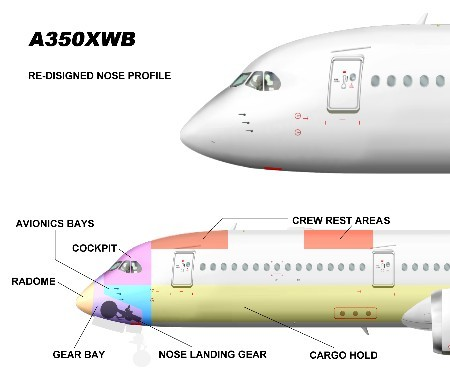
A plan of the A350 XWB's new nose and general arrangement inside the forward fuselage.
Airbus suggested Boeing's use of composite materials for the 787 fuselage was premature, and that the new A350 XWB was to feature large carbon fibre panels for the main fuselage skin. After facing criticism for maintenance costs,[44] Airbus confirmed in early September 2007 the adoption of composite fuselage frames for the aircraft structure.[45][46] The composite frames would feature aluminium strips to ensure the electrical continuity of the fuselage (for dissipating lightning strikes).[47] Airbus used a full mock up fuselage to develop the wiring, a different approach from the A380, on which the wiring was all done on computers.[48]
In 2006, Airbus confirmed development of a full bleed air system on the A350, as opposed to the 787's bleedless configuration.[49][50][51] Rolls-Royce agreed with Airbus to supply a new variant of the Trent turbofan engine for the A350 XWB, named Trent XWB. In 2010, after low-speed wind tunnel tests, Airbus finalised the static thrust at sea level for all three proposed variants to the 330–420 kN (74,000–94,000 lbf) range.[52]
General Electric (GE) stated it would not offer the GP7000 engine on the aircraft, and that previous contracts for the GEnx on the original A350 did not apply to the XWB.[53] Engine Alliance partner Pratt & Whitney seemed to be at odds with GE on this, having publicly stating that it was looking at an advanced derivative of the GP7000.[54] In April 2007, Airbus former chief executive Louis Gallois held direct talks with GE management over developing a GEnx variant for the A350 XWB.[55][56] In June 2007, Airbus's chief operating officer John Leahy indicated that the A350 XWB would not feature the GEnx engine, saying that Airbus wanted GE to offer a more efficient version for the airliner.[57] Since then, the largest GE engines operators, which include Emirates, US Airways, Hawaiian Airlines and ILFC have selected the Trent XWB for their A350 orders. In May 2009, GE said that if it were to reach a deal with Airbus to offer the current 787-optimised GEnx for the A350, it would only power the -800 and -900 variants. GE believed it can offer a product that outperforms the Trent 1000 and Trent XWB, but was reluctant to support an aircraft competing directly with its GE90-115B-powered 777 variants.[58]
In January 2008, French-based Thales Group won a US$2.9 billion (€2 billion) 20-year contract to supply avionics and navigation equipment for the A350 XWB, beating Honeywell and Rockwell Collins.[59] US-based Rockwell Collins and Moog Inc. were chosen to supply the horizontal stabiliser actuator and primary flight control actuation, respectively. The flight management system incorporated several new safety features.[60] Regarding cabin ergonomics and entertainment, in 2006 Airbus signed a firm contract with BMW for development of an interior concept for the original A350.[61] On 4 February 2010, Airbus signed a contract with Panasonic Avionics Corporation to deliver in-flight entertainment and communication (IFEC) systems for the Airbus A350 XWB.[62]
Production
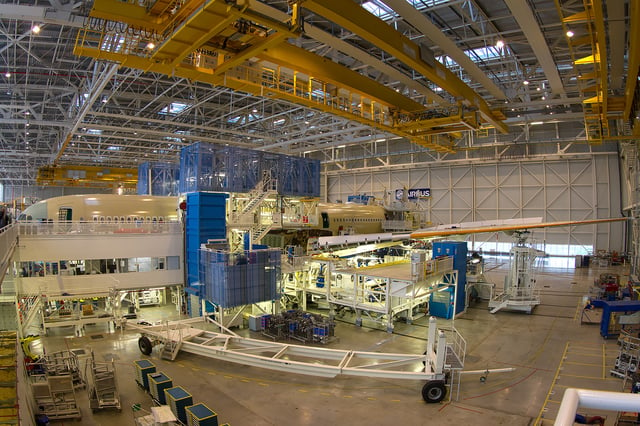
A partially-complete A350-900 XWB (destined for Finnair) on the Toulouse assembly line, December 2014
In 2008, Airbus planned to introduce new techniques and procedures to cut assembly time in half.[63] The A350 XWB production programme sees extensive international collaboration and investments in new facilities: Airbus constructed 10 new factories in Western Europe and the US, with extensions carried out on 3 further sites.[64]
Among the new buildings was a £570 million (US$760 million or €745 million) composite facility in Broughton, Wales, which would be responsible for the wings.[65] In June 2009, the National Assembly for Wales announced provision of a £28 million grant to provide a training centre, production jobs and money toward the new production centre.[66]
The new composite rudder plant in China opened in early 2011.[70] The forward fuselage of the first A350 was delivered to the final assembly plant in Toulouse on 29 December 2011.[71] Final assembly of the first A350 static test model was started on 5 April 2012.[72] Final assembly of the first prototype A350 was completed in December 2012.[73]
The production rate was expected to rise from three aircraft per month in early 2015 to five at the end of 2015, and would ramp to ten aircraft per month by 2018.[74] In 2015, 17 planes would be delivered and the initial dispatch reliability was 98%.[75] Airbus plans to increase its production rate from 10 monthly in 2018 to 13 monthly from 2019, while the Boeing 787 production will increase from 12 to 14 per month in 2019, and six A330 are produced monthly.[76] Around 90 deliveries are expected in 2018, with about 15% -1000s (≈14).[77]
Testing and certification
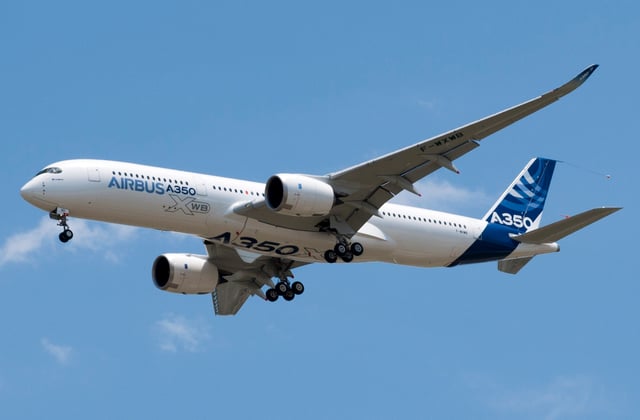
A prototype Airbus A350-900 XWB (registered as F-WXWB) during its first flight.
The first Trent engine test was made on 14 June 2010.[78] The Trent XWB's flight test programme began use on the A380 development aircraft in early 2011, ahead of engine certification in late 2011. On 2 June 2013, the Trent XWB engines were powered up on the A350 for the first time. Airbus confirmed that the flight test programme would last 12 months and use five test aircraft.[79]
The A350's maiden flight took place on 14 June 2013 from the Toulouse–Blagnac Airport.[80] Airbus's chief test pilot said, "it just seemed really happy in the air...all the things we were testing had no major issues at all."[81] It flew for 4 hours, reaching Mach .8 at 25,000 feet after retracting the landing gear and starting a 2,500 h flight test campaign.[82] Development costs were estimated at €11 billion (US$15 billion or £9.5 billion) in June 2013.[10]
A350 XWB, F-WWCF, msn. 2, underwent two-and-a-half weeks of climatic tests in the unique McKinley Climatic Laboratory at Eglin Air Force Base, Florida, in May 2014, and was subjected to multiple climatic and humidity settings from a high of 45 °C to as low as -40 °C.[83]
The A350 received type certification from the European Aviation Safety Agency (EASA) on 30 September 2014.[84] On 15 October 2014, EASA approved the A350-900 for ETOPS 370, allowing it to fly more than six hours on one engine and making it the first airliner to be approved for "ETOPS Beyond 180 minutes" before entry into service.[85] Later that month Airbus received regulatory approval for a Common Type Rating for pilot training between the A350 XWB and A330.[86] On 12 November 2014, the A350 received certification from the US Federal Aviation Administration.[87]
On 1 August 2017, the EASA issued an airworthiness directive mandating operators to power cycle (reset) early A350-900s before 149 hours of continuous power-on time, reissued in July 2019.[88]
Introduction and early operations
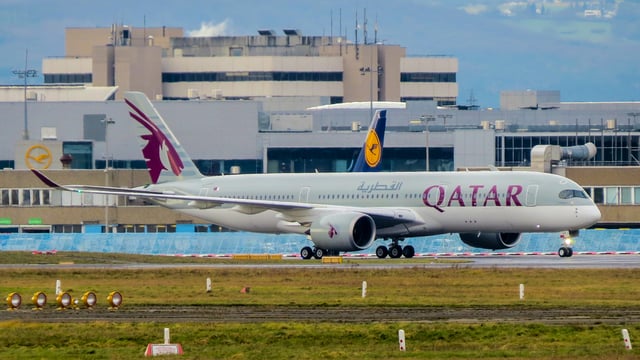
Qatar Airways' first A350-900 XWB (registration: A7-ALA) after the first commercial flight to Frankfurt Airport.
In June 2011, the A350-900 was scheduled to enter service in the first half of 2014, with the -800 to enter service in mid-2016, and the -1000 in 2017.[89] In July 2012, Airbus delayed the -900's introduction by three months to the second half of 2014.[90] The first delivery to launch customer Qatar Airways took place on 22 December 2014.[91] The first commercial flight was made on 15 January 2015 between Doha and Frankfurt.[7]
One year after introduction, the A350 fleet had accumulated 3,000 cycles and around 16,000 flight hours. Average daily usage by first customers was 11.4 hours with flights averaging 5.2 hours, which are under the aircraft's capabilities and reflect both short flights within the schedules of Qatar Airways and Vietnam Airlines, as well as flight-crew proficiency training that is typical of early use and is accomplished on short-haul flights. Finnair was operating the A350 at very high rates: 15 flight hours per day for Beijing, 18 hours for Shanghai, and more than 20 hours for Bangkok.[92] This may have accelerated its retirement of the Airbus A340.[92]
In service problems had included three areas. The onboard Maintenance, Repair, Overhaul network needed software improvements. Airbus issued service bulletins regarding onboard equipment and removed galley inserts (coffee makers, toaster ovens) because of leaks. Airbus had to address spurious overheating warnings in the bleed air system by retrofitting an original connector with a gold-plated connector. Airbus targeted a 98.5 percent dependability by the end of 2016 and to match the mature A330 reliability by early 2019.[92]
By the end of May 2016, the in-service fleet had flown 55,200 hours over 9,400 cycles at a 97.8 percent operational reliability on three months. The longest operated sector was Qatar Airways' Adelaide–Doha at 13.8 hours for 6,120 nmi (11,334 km). 45 percent of flights were under 3,000 nmi (5,556 km), 16 percent over 5,000 nmi (9,260 km), and 39 percent in between. The average flight was 6.8 hours, with the longest average being 9.6 hours by TAM Airlines and the shortest being 2.1 hours by Cathay Pacific's. Aircraft seat configuration ranged from 253 seats for Singapore Airlines to 348 seats for TAM Airlines, with a 30 to 46 seat business class and a 211 to 318 seat economy class, often including a premium economy.[93]
The first A350-1000 was assembled in 2016, for a first flight on 24 November and entry into service planned for mid-2017.[94]
In January 2017, two years after introduction, 62 aircraft were in service with 10 airlines. They had accumulated 25,000 flights over 154,000 hours with an average daily utilisation of 12.5 hours, and transported six million passengers with a 98.7 percent operational reliability.[95] Zodiac Aerospace had business class seats production difficulties in its Gainesville, Texas and Santa Maria, California factories. After a year, Cathay Pacific experienced cosmetic quality issues and upgraded or replaced the seats for the earliest cabins.[96]
In June 2017 after 30 months in commercial operation, 80 A350 were in service with 12 operators, the largest being Qatar Airways with 17 and 13 each at Cathay Pacific and Singapore Airlines (SIA).[99] The fleet average block time (time between pushback and destination gate arrival) was 7.2 hours with 53 percent below 3,000 nmi (5,556 km), 16 percent over 5,000 nmi (9,260 km), and 31 percent in between. LATAM Airlines had the longest average sector at 10.7 hours, and Asiana had the shortest at 3.8 hours.[99] Singapore Airlines operated the longest leg, Singapore to San Francisco 7,340 nmi (13,594 km), and the shortest leg, Singapore to Kuala Lumpur 160 nmi (296 km).[99] In 2016, 49 were delivered and the monthly rate should grow to 10 by the end of 2018.[99] Seating varied from 253 for Singapore Airlines to 389 for Air Caraïbes, with most between 280 and 320.[99]
In October 2017, Airbus was testing extended sharklets, which could offer 100–140 nmi (185–259 km) extra range and reduce fuel burn by 1.4–1.6 percent.[100] The wing twist is being changed for the wider, optimised spanload pressure distribution, and they will be used for the Singapore Airlines A350-900ULR in 2018 before spreading to other variants.[101] Iberia was the first to get the upgraded -900 on 26 June 2018, with a 280 t (617,294 lb) MTOW version for an 8,200 nmi (15,186 km) range with 325 passengers in three classes.[102][103]
As of February 2018, 142 -900s had been delivered, with a dispatch reliability of 99.3 percent.[104]
By April 2019, Airbus was testing a hybrid laminar flow control (HLFC) on the leading edge of an A350 prototype vertical stabilizer, with passive suction like the boundary layer control on the Boeing 787-9 tail, but unlike the natural laminar flow BLADE, within the same EU Clean Sky program.[105]
Design
Overview
In September 2007, Airbus rolled out new design advances to a gathering of 100 representatives from existing and potential XWB customers. The A350 XWB is based on the technologies developed for the Airbus A380 and includes a similar cockpit and fly-by-wire systems layout.
Materials
The A350 XWB airframe is made out of 53 percent composites: carbon fibre reinforced plastic for the outer and centre wing box (covers, stringers, spars), fuselage (skin, frame, keel beam, and rear fuselage) and the empennage (horizontal and vertical tailplanes); 19 percent aluminium and aluminium–lithium alloy for ribs, floor beams, and gear bays; 14 percent titanium for landing gears, pylons, and attachments; 6 percent steel; and 8 percent miscellaneous.[108] The A350's competitor, the Boeing 787, is 50 percent composites, 20 percent aluminium, 15 percent titanium, 10 percent steel, and 5 percent other.[109]
Fuselage
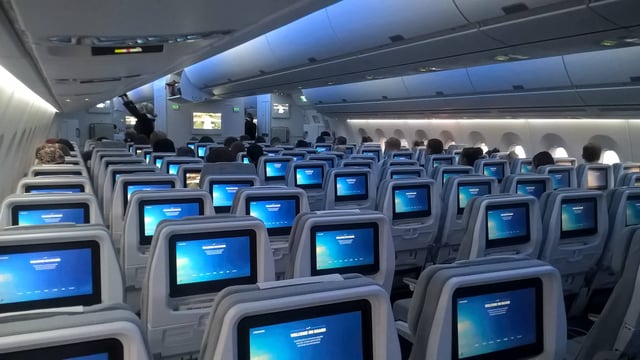
Nine-abreast Economy Class cabin on a Finnair A350-900 XWB.
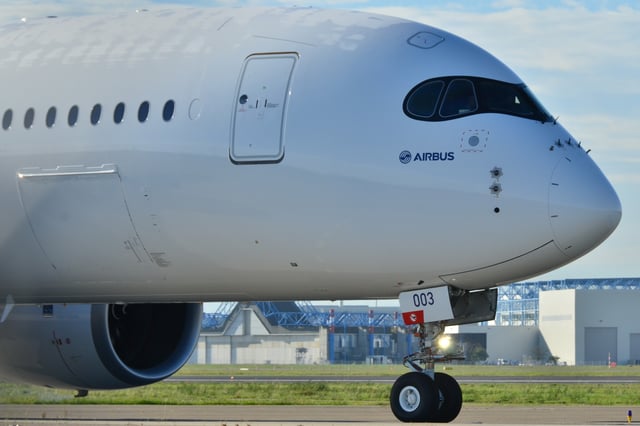
The Airbus A350's nose.
The A350 XWB fuselage has a constant width from door 1 to door 4, unlike previous Airbus aircraft, to provide maximum usable volume.[110] The double-lobe (ovoid) fuselage cross-section has a maximum outer diameter of 5.97 m (19.6 ft), compared to 5.64 m (18.5 ft) for the A330/A340.[111] The cabin's internal width is 5.61 m (18.4 ft) at armrest level compared to 5.49 m (18.0 ft) in the Boeing 787[112] and 5.87 m (19.3 ft) in the Boeing 777. It allows for an eight-abreast 2–4–2 arrangement in a premium economy layout, with the seats being 49.5 cm (19.5 in) wide between 5 cm (2.0 in) wide arm rests. Airbus says that the seat will be 1.3 cm (0.5 in) wider than a 787 seat in the equivalent configuration. In the nine-abreast, 3–3–3 standard economy layout, the A350 seat will be 45 cm (18 in) wide, 1.27 cm (0.5 in) wider than a seat in the equivalent layout in the 787,[113] and 3.9 cm (1.5 in) wider than a seat in the equivalent A330 layout.[114] The current 777 and future derivatives have 1.27 cm (0.5 in) greater seat width than the A350 in a nine-abreast configuration.[115][116][117] The 10-abreast seating on the A350 is similar to a 9-abreast configuration on the A330, with a seat width of 41.65 cm (16.4 in).[30][118] Overall, Airbus promises passengers more headroom, larger overhead storage space, and wider panoramic windows than current Airbus models.
The A350 nose section has a configuration derived from the A380 with a forward-mounted nosegear bay and a six-panel flightdeck windscreen.[119] This differs substantially from the four-window arrangement in the original design.[120] The new nose, made of aluminium,[121] improves aerodynamics and enables overhead crew rest areas to be installed further forward and eliminate any encroachment in the passenger cabin. The new windscreen has been revised to improve vision by reducing the width of the centre post. The upper shell radius of the nose section has been increased.[122]
Undercarriage
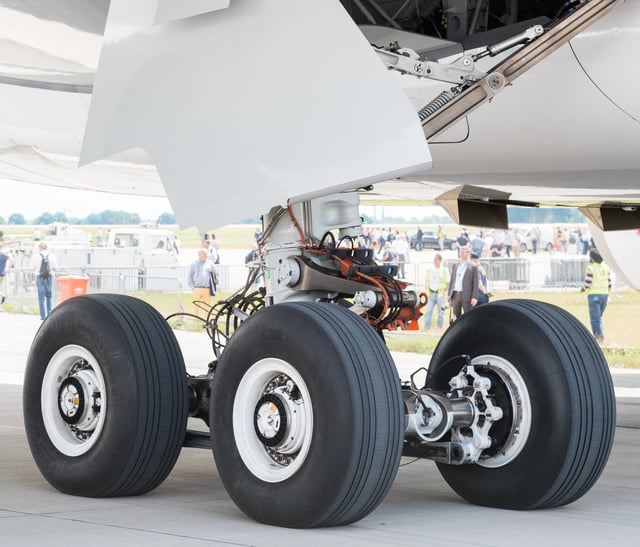
An A350-900's four-wheel main landing gear.
Airbus adopted a new philosophy for the attachment of the A350's main undercarriage as part of the switch to a composite wing structure. Each main undercarriage leg is attached to the rear wing spar forward and to a gear beam aft, which itself is attached to the wing and the fuselage. To help reduce the loads further into the wing, a double side-stay configuration has been adopted. This solution resembles the design of the Vickers VC10.[123]
Airbus devised a three-pronged main undercarriage design philosophy encompassing both four- and six-wheel bogies to stay within pavement loading limits. The A350-900 has four-wheel bogies in a 4.1 m (13 ft) long bay. The higher weight variant, the A350-1000 uses a six-wheel bogie, with a 4.7 m (15 ft) undercarriage bay.[124] French-based Messier-Dowty provides the main undercarriage for the -900 variant, and UTC Aerospace Systems supplies the −1000 variant. The nose gear is supplied by Liebherr Aerospace.[125]
Wing
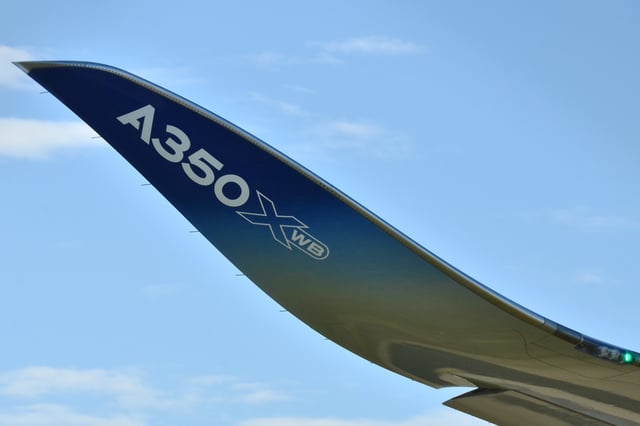
The Airbus A350's blended winglets.
The A350 features new composite wings with a wingspan that is common to the proposed variants.[126] Its 64.75 m (212.4 ft) wingspan stays within the same ICAO Aerodrome Reference Code E 65m limit as the A330/A340[127] and the Boeing 777.[128] The A350's wing has a 31.9° sweep angle for a Mach 0.85 cruise speed and has a maximum operating speed of Mach 0.89.[129]
The -900 wing covers a 442 m2 (4,760 sq ft) area.[130] This is between the 436.8 m2 (4,702 sq ft) wing of the current Boeing 777-200LR/300ER and the 466.8 m2 (5,025 sq ft) wing of the in-development Boeing 777X.[131] However, Boeing and Airbus do not use the same measurement.[132] The A350-1000 wing is 22.3 m² (240 ft²) larger through a 30 cm (12 in) extension to the inboard sections of the fixed trailing edge.[133]
A new trailing-edge high-lift device has been adopted with an advanced dropped-hinge flap similar to that of the Airbus A380, which permits the gap between the trailing edge and the flap to be closed with the spoiler.[134] It is a limited morphing wing with adaptive features for continuously optimising the wing loading to reduce fuel burn: variable camber for longitudinal load control where inboard & outboard flaps deflect together and differential flaps setting for lateral load control where inboard & outboard flaps deflect differentially.[135]
The manufacturer has extensively used computational fluid dynamics and also carried out more than 4,000 hours of low- and high-speed windtunnel testing to refine the aerodynamic design.[136] The final configuration of wing and winglet was achieved for the "Maturity Gate 5" on 17 December 2008.[137] The wingtip device curves upwards over the final 4.4 m (14 ft).[110]
The wings are produced in the new £400M, 46,000 m2 (500,000 sq ft) North Factory at Airbus Broughton, employing 650 workers, in a specialist facility constructed with £29M of support from the Welsh Government.[138]
Cockpit and avionics
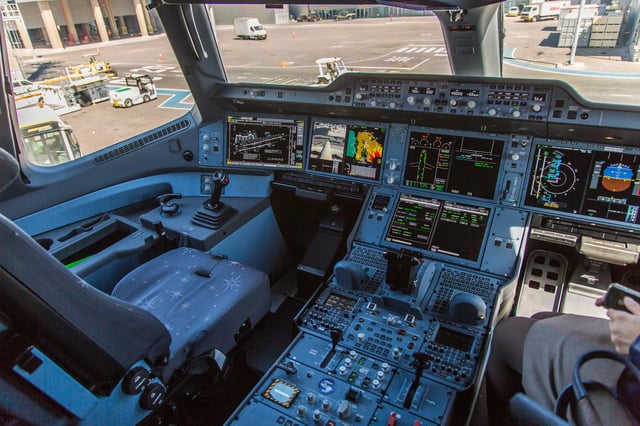
The cockpit of the Airbus A350
The revised design of the A350 XWB's glass cockpit dropped the A380-sized display and adopted 38 cm (15 in) liquid-crystal display screens. The new six-screen configuration includes two central displays mounted one above the other (the lower one above the thrust levers) and a single (for each pilot) primary flight/navigation display, with an adjacent on-board information system screen.[139] Airbus says the cockpit design allows for future advances in navigation technology to be placed on the displays plus gives flexibility and capacity to upload new software and to combine data from multiple sources and sensors for flight management and aircraft systems control.[140] A head-up display is also present in the cockpit.
Avionics are a further development of the integrated modular avionics (IMA) concept found on the A380. The A350's IMA will manage up to 40 functions (versus 23 functions for the A380) such as undercarriage, fuel, pneumatics, cabin environmental systems, and fire detection.[120][140] Airbus stated that the benefits includes reduced maintenance and lower weight because as the IMA replaces multiple processors and LRUs with around 50 percent fewer standard computer modules known as line-replaceable modules. The IMA runs on a 100 Mbit/s network based on the AFDX standard, as employed in the A380, in place of the architecture used on the A330/A340.
Propulsion
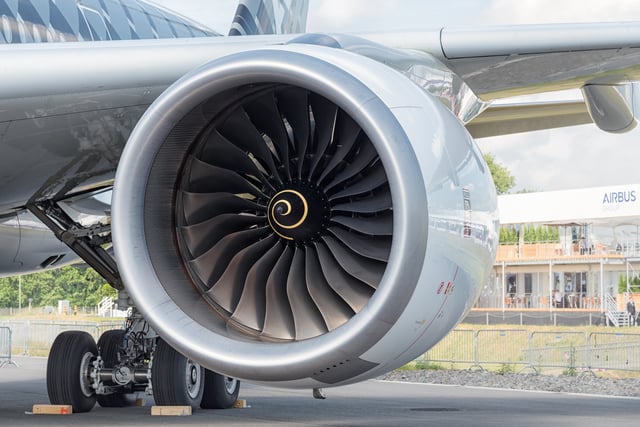
A Rolls-Royce Trent XWB engine, used exclusively on the A350 XWB series.
The Rolls-Royce Trent XWB feature a 118 in (300 cm) fan disk diameter and the design will be based on the advanced developments of the Airbus A380 Trent 900 and the Boeing 787 Trent 1000. It has four thrust levels to power the A350 variants: a 75,000 lbf (330 kN) and 79,000 lbf (350 kN) for the regional variants of the A350-900 while the baseline A350-900 has the standard 84,000 lbf (370 kN) and a 97,000 lbf (430 kN) for the A350-1000.[141] The higher-thrust version will have some modifications to the fan module—it will be the same diameter but will run slightly faster and have a new fan blade design—and run at increased temperatures allowed by new materials technologies from Rolls-Royce's research.[142]
The Trent XWB may also benefit from the next-generation reduced acoustic mode scattering engine duct system (RAMSES), an acoustic quieting engine nacelle intake, and a carry-on design of the Airbus's "zero splice" intake liner developed for the A380.[143] A "hot and high" rating option for Middle Eastern customers Qatar Airways, Emirates, and Etihad Airways keep its thrust available at higher temperatures and altitudes.
Airbus aimed to certify the A350 with 350-minute ETOPS capability on entry into service.[144] That could reach 420 min later,[145] although Airbus achieved a 370–minute ETOPS rating on 15 October 2014 which covers 99.7% of the Earth's surface.[146] Engine thrust-reversers and nacelles are supplied by US-based UTC Aerospace Systems.[147][148]
Systems
Honeywell supplies its 1,700 hp (1,268 kW) HGT1700 auxiliary power unit with 10 percent greater power density than the TPE331 from which it is developed, and the air management system: the bleed air, environmental control, cabin pressure control and supplemental cooling systems.[149] Airbus says that the new design provides a better cabin atmosphere with 20 percent humidity, a typical cabin altitude at or below 6,000 ft (1,800 m) and an airflow management system that adapts cabin airflow to passenger load with draught-free air circulation.[12]
The ram air turbine, capable of generating 100 kilovolt-ampere, is supplied by Hamilton Sundstrand and located in the lower surface of the fuselage.[150] In light of the Boeing 787 Dreamliner battery problems, in February 2013 Airbus decided to revert from lithium-ion to the proven nickel-cadmium technology although the flight test programme will continue with the lithium-ion battery systems.[151] In late 2015, MSN24 was delivered with 176 lb (80 kg) lighter Saft Li-ion batteries and in June 2017, fifty A350s were flying with them and benefiting from a two-year maintenance schedule instead of NiCd's 4–6 months.[152]
Parker Hannifin supplies the complete fuel package: inerting system, fuel measurement and management systems, mechanical equipment and fuel pumps. The fuel tank inerting system features air-separation modules to generate nitrogen-enriched air to reduce the flammability of fuel vapour in the tanks. Parker also provides hydraulic power generation and distribution system: reservoirs, manifolds, accumulators, thermal control, isolation, software and new engine- and electric motor-driven pump designs. Parker estimates the contracts will generate more than $2 billion in revenues over the life of the programme.[153]
Variants

Comparative lengths of the three variants, with the now-cancelled -800.
The three main variants of the A350 were launched in 2006, with entry into service planned for 2013.[35] At the 2011 Paris Air Show, Airbus postponed the entry into service of the A350-1000 by two years to mid-2017.[89] In July 2012, the A350's entry into service was delayed to the second half of 2014,[90] before the -900 began service on 15 January 2015.[7] In October 2012, the -800 was due to enter service in mid-2016,[154] but its development has been cancelled since September 2014.[155] The A350 is also offered as the ACJ350 corporate jet by Airbus Corporate Jets (ACJ), offering a 20,000 km (10,800 nmi) range for 25 passengers for the -900 derivative.[156]
A350-900
The A350-900 is the first A350 model, has a maximum takeoff weight (MTOW) of 280 tonnes,[157] typically seats 325 passengers, and has a range of 8,100 nmi (15,001 km).[158] Airbus says that per seat, the Boeing 777-200ER should have a 16 percent heavier manufacturer's empty weight, a 30 percent higher block fuel consumption, and 25 percent higher cash operating costs than the A350-900.[159] The −900 is designed to compete with the Boeing 777 and 787[160] (777-200ER/LR, Boeing 777-8, and Boeing 787-10), while replacing the Airbus A340-300 and A340-500.
A proposed A350−900R extended-range variant was to feature the higher engine thrust, strengthened structure, and landing gear of the 308 tonnes MTOW -1000 to give a further 800 nmi (1,500 km) range.[161] An A350−900F freighter with a 5,000 nmi (9,260 km) range and a similar payload and volume to the 91.7 tonne and 440 m3 (16,000 cu ft) McDonnell Douglas MD-11F should be studied after the -1000 is done, depending on market demand.[162]
Philippine Airlines will replace its A340-300 with an A350-900HGW.[163] high gross weight version available from 2017. It will enable non-stop Manila-New York City flights without payload limitations in either direction,[164] a 7,404 nmi (13,712 km) flight.[165] The PAL version will have a 278 tonne MTOW, and from 2020, the -900 will be proposed with the ULR's 280 tonne MTOW, up from the 268 tonnes for the original weight variant and the certified 260, 272, and 275 tonne variants, with the large fuel capacity. This will enable a 8,100 nmi (15,001 km) range with 325 seats in a three-class layout.[166]
In early November 2017, Emirates committed to purchase 40 Boeing 787-10 aircraft before Airbus presented a picture-changing A350-900 layout with the rear pressure bulkhead pushed back by 2.5 ft (1 m).[167] After Emirates' Tim Clark was shown a ten-abreast economy cabin and galley changes, he said the -900 is "more marketable" as a result.[168]
The average lease rates of the first A350-900s produced in 2014 were $1.1 million per month, not including maintenance reserves amounting to $18 million after 10–12 years, and falling to $940,000 per month in 2018 while a new A350-900 is leased for $1.2 million per month and its interior can cost $12 million, 10% of the aircraft.[169] By 2018, a 2014 build was valued $108M falling to $74.5M by 2022 while a new build was valued for $148M, a 6+12year check cost $3M and an engine overhaul $4–6.5M.[170]
A350-900ULR
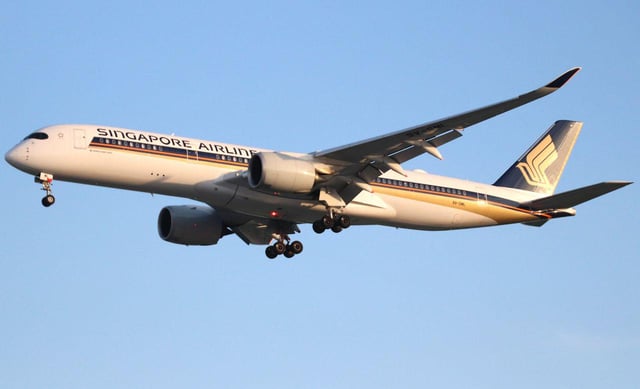
Singapore Airlines launched the A350-900ULR, externally identical to the pictured A350-900
The MTOW of the ultra-long range -900ULR has been increased to 280 t (620,000 lb) and its fuel capacity increased from 141,000 to 165,000 l (37,000 to 44,000 US gal) within existing fuel tanks, enabling up to 19-hour flights with a 9,700 nmi (18,000 km) range.[171] The MTOW is increased by 5 tonnes from the previously certified 275 tonnes variant.[157] Due to the A350-900's fuel consumption of 5.8 tonnes/hour, it needs an additional 24 tonnes of fuel to fly 19 hours instead of the standard 15 hours: the increased MTOW and lower payloads will enable the larger fuel capacity.[172] Non-stop flights could last more than 20 hours.[173] The first −900ULR was rolled out without its engines in February 2018 for ground testing, and debuted flight-tests after engine installation to check the larger fuel capacity and to measure the performance improvements from the extended winglets.[174] It made its first flight on 23 April 2018.[175]
Singapore Airlines, the launch customer, will use its seven -900ULR aircraft on non-stop flights between Singapore and New York City, and cities on the U.S. west coast.[176] Singapore Airlines' seating is to be from 170 in largely business class seating up to over 250 in mixed seating.[177] The planes can be reconfigured.[178] They will have two seating classes.[179] The airline received its first -900ULR on 23 September 2018, with 67 business class seats and 94 premium economy seats.[180] On 12 October, it landed the world's longest flight in New York/Newark from Singapore Changi after 17 h 52 min.[181] The flight covered 16,562 km (8,943 nmi) for a 15,353 km (8,290 nmi) orthodromic distance.[182] It burned 101.4 t (224,000 lb) of fuel to cover the route in 17h22min: an average of 5.8 t/h.[183]
ACJ350
Airbus Corporate Jet version of the A350, the ACJ350, is derived from the A350-900ULR. As a result of the increased fuel capacity from the -900ULR, the ACJ350 has a maximum range of 20,000 km (10,800 nmi).[187]
A350 Regional
After the Boeing 787-10 launch at the 2013 Paris Air Show, Airbus discussed with airlines a possible A350-900 Regional with a reduced MTOW of 250 t (550,000 lb).[188] Engine thrust would have been reduced to 70,000–75,000 lbf (310–330 kN) from the standard 85,000 lbf (380 kN) and the variant would have been optimised for routes up to 6,800 nmi (12,594 km) with seating for up to 360 passengers in a single-class layout.[189] The A350 Regional was expected to be ordered by Etihad Airways[190] and Singapore Airlines.[191] Since 2013, there has been no further announcement about this variant.
Singapore Airlines selected an A350-900 version for medium-haul use,[192] with a derated engine option and weight limits. Japan Airlines took delivery of a 369-seat A350-900 with a 217 t (478,000 lb) MTOW for its domestic market.[193] The A350 Type Certificate Data Sheet includes MTOWs of 217, 235, 240, 250, 255, 260, 268, 272, 275, 277, 278 and 280 t.[194]
A350-1000
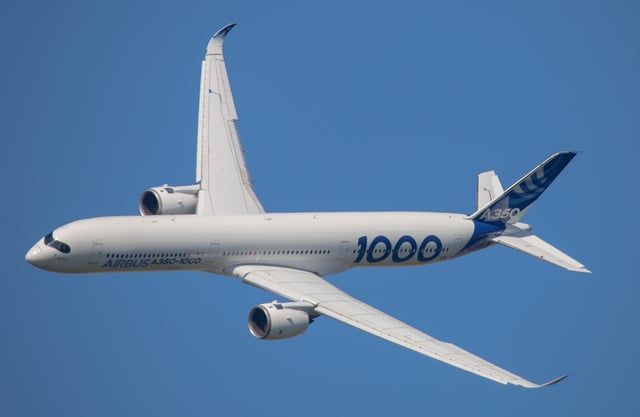
The 73.8 m (242 ft) long A350-1000 first flew on 24 November 2016

Qatar Airways was the A350-1000 XWB launch operator in February 2018
The A350-1000 is the largest variant of the A350 family at just under 74 metres in length. It seats 366 passengers in a typical three-class layout with a range of 8,000 nmi (14,800 km).[195] With a 9-abreast configuration, it is designed to replace the A340-600 and compete with the Boeing 777-300ER and 777-9. Airbus estimates a 366-seat -1000 should have a 35 t lighter operating empty weight than a 398-seat 777-9, a 15% lower trip cost, a 7% lower seat cost, and a 400 nmi (740 km) greater range.[196] Compared to a Boeing 777-300ER with 360 seats, Airbus claims a 25% fuel burn per seat advantage for an A350-1000 with 369 seats.[197] The 7 m (23 ft) extension seats 40 more passengers with 40% more premium area.[135] The -1000 can match the 40 more seats of the 777-9 by going 10-abreast but with diminished comfort.[198]
The A350-1000 has an 11-frame stretch over the −900 and a slightly larger wing than the −800/900 models with trailing-edge extension increasing its area by 4%. This will extend the high-lift devices and the ailerons, making the chord bigger by around 400 mm, optimising flap lift performance as well as cruise performance.[199] The main landing gear is a 6-wheel bogie instead of a 4-wheel bogie, put in a one frame longer bay. The Rolls-Royce Trent XWB engine's thrust is augmented to 97,000 lbf (430 kN).[200] These and other engineering upgrades are necessary so that the −1000 model maintains range.[201]
In 2011, Airbus redesigned the A350-1000 with higher weights and a more powerful engine variant for more range for trans-Pacific operations which will boost its appeal to Cathay Pacific and Singapore Airlines, which committed to 20 777-9, and United Airlines, which could turn to 777-300ERs to replace its 747-400s. Emirates was disappointed with the changes and cancelled its order for 50 A350-900s and 20 A350-1000s instead of changing the whole order to the larger variant.[202]
Assembly of the first fuselage major components started in September 2015.[195] In February 2016, final assembly started at the A350 Final Assembly Line in Toulouse. Three flight test aircraft was planned with entry into service scheduled for mid-2017.[203] The first aircraft completed its body join on 15 April 2016.[204] Its maiden flight took place on 24 November 2016.[94]
The A350-1000 flight-test programme planned for 1,600 flight hours; 600 hours on the first aircraft, MSN59, for the flight envelope, systems and powerplant checks; 500 hours on MSN71 for cold and warm campaigns, landing gear checks and high-altitude tests; and 500 hours on MSN65 for route proving and ETOPS assessment, with an interior layout for cabin development and certification.[205] In cruise at Mach 0.854 (912 km/h; 492 kn) and 35,000 ft, its fuel flow at 259 t (571,000 lb) is 6.8 t (15,000 lb) per hour within a 10,000 km (5,400 nm), 11 h 30 m early long test flight.[206] Flight tests allowed raising the Maximum Take-Off Weight from 308 to 316 t (679,000 to 697,000 lb), the 8 t (18,000 lb) increase giving 450 nmi (830 km) more range.[207] Airbus then completed functional and reliability testing.[208]
Type Certification was awarded by EASA on 21 November 2017,[194] along FAA certification. The first serial unit was on the final assembly line in early December.[209] After its maiden flight on 7 December, delivery to launch customer Qatar Airways slipped to early 2018.[210] The delay was due to issues with the business class seat installation.[211] It was delivered on 20 February[212] and entered commercial service on Qatar Airways' Doha to London Heathrow route on 24 February.[213]
It features an automatic emergency descent function to around 10,000 ft (3,000 m) and notifies air traffic control if the crew fails to respond to an alert, indicating possible incapacitation from depressurisation. The avionics software adaptation is activated by a push and pull button to avoid mistakes and could be retrofitted in the smaller -900.[214] All performance targets have been met or exceeded and it remains within its weight specification, unlike early −900s.[209] Its basic 308 t (679,000 lb) maximum take-off weight was bumped to 311 t (686,000 lb) before offering a possible 316 t (697,000 lb) version.[215] Its 316 t MTOW appeared in the 29 May 2018 update of its type certificate data sheet.[194] This raised its range from 7,950 to 8,400 nmi (14,720 to 15,560 km).[216] A further MTOW increase by 3 t to 319 t is under study to be available from 2020 and could be a response to Qantas' Project Sunrise.[217] The added range potentially enabled by the MTOW increase could result in the variant being marketed as the A350-1000ULR.[218]
Further stretch
Airbus has explored the possibility of a further stretch offering 45 more seats.[219] A potential 4 m stretch would remain within the exit limit of four door pairs, and a modest MTOW increase from 308 t to 319 t would need only 3% more thrust, within the Rolls-Royce Trent XWB-97 capabilities, and would allow a 14,100 km (7,600 nmi) range to compete with the Boeing 777-9 capabilities.[220]
This variant was to be a replacement for the Boeing 747-400,[221] tentatively dubbed the A350-8000,[222] -2000[223] or -1100.[219] Within the June 2016 Airbus Innovation Days, chief commercial officer John Leahy was concerned about the size of a 400-seat market besides the Boeing 747-8 and the 777-9 and chief executive Fabrice Brégier feared such an aircraft could cannibalise demand for the -1000.[223]
The potential 79 m-long (258 ft) aeroplane was competing against a hypothetical 777-10X for Singapore Airlines.[224] At the 2017 Paris Air Show, the concept was shelved for lacking market appeal and in January 2018 Fabrice Brégier focused on enhancing the A350-900/1000 to capture potential before 2022/2023, when it will be possible to stretch the A350 with a new engine generation.[225]
Undeveloped A350-800
The 60.45 m (198.3 ft) long A350-800 was designed to seat 276 passengers in a typical 3-class configuration with a range of 15,270 km (8,245 nmi) with an MTOW of 259 t (571,000 lb).[226]
In January 2010 Airbus opted to develop the -800 as a shrink of the baseline -900, avoid a specific development and increasing its payload by 3 t (6,600 lb) or its range by 460 km (250 nmi) but leading to a fuel burn penalty by "a couple of percent" according to John Leahy.[227] The previously planned optimisation to the structure and landing gear was not beneficial enough against better commonality and maximum takeoff weight increase by 11t from 248t.[228] The −800's fuselage is 10 frames shorter (six forward and four aft of wing) than the −900 aircraft.[229] It was designed to supplement the Airbus A330-200 long-range twin.[230] Airbus planned to decrease structural weight in the -800 as development continued, which should have been around airframe 20.[231]
While its backlog reached 182 in mid-2008, it diminished since 2010 as customers switched to the larger -900.[232] After launching the Airbus A330neo at the 2014 Farnborough Airshow, Airbus dropped the A350-800, with its CEO Fabrice Brégier saying "I believe all of our customers will either convert to the A350-900 or the A330neo".[233] He later confirmed at a September 2014 press conference that development of the A350-800 had been "cancelled."[155] There were 16 orders left for the -800 since Yemenia switched to the -900 and Hawaiian Airlines moved to the A330neo in December 2014: 8 for Aeroflot and 8 for Asiana Airlines, both also having orders for the -900.[234] In January 2017, Aeroflot and Airbus announced the cancellation of its -800 order, leaving Asiana Airlines as the only customer for the variant.[235] After the negotiation between Airbus and Asiana Airlines,[236] Asiana converted orders of eight A350-800s and one A350-1000 to nine A350-900s.[237]
New Engine Option
By November 2018, Airbus was hiring in Toulouse and Madrid to develop a re-engined A350neo. Although its launch is not guaranteed, it would be delivered in the mid-2020s, after the A321XLR and a stretched A320neo "plus" competing with the Boeing New Midsize Airplane which may be launched in 2019. Service entry would be determined by ultra-high bypass ratio engine developments pursued by Pratt & Whitney, testing its Geared Turbofan upgrade; Safran Aircraft Engines, ground testing a demonstrator from 2021; and Rolls-Royce Plc, targeting a 2025 Ultrafan service entry. The production target is a monthly rate of 20 A350neos, up from 10.[238]
Orders and deliveries
| Total orders | Total deliveries | |
| A350-900 | 733 | 273 |
| A350-1000 | 180 | 27 |
| Total | 913 | 300 |
As of 31 August 2019[9]
Orders and deliveries, cumulative, by year:
Orders
Deliveries
As of 31 August 2019[9]
Operators
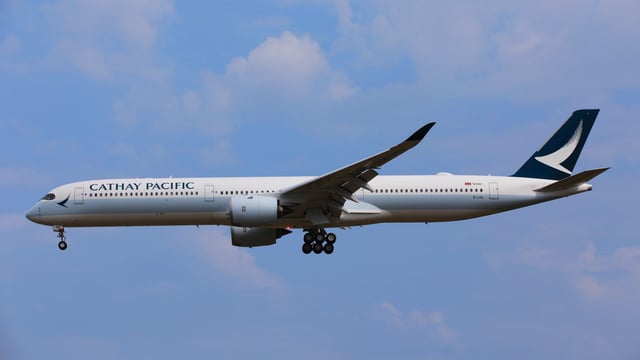
An A350-1000 XWB of Cathay Pacific, the third largest A350 operator after Qatar Airways and Singapore Airlines.
| Operator | First commercial service | Number in service |
|---|---|---|
| Air Caraïbes | 2 March 2017[241] | 2 |
| Air Mauritius | 23 October 2017 | 2 |
| Air China | 14 August 2018[242][243][244] | 10 |
| Asiana Airlines | 15 May 2017[245] | 9 |
| British Airways | 5 August 2019[246] | 2 |
| Cathay Pacific | 1 June 2016[247][248] | 35 |
| China Airlines | 30 October 2016[249] | 15 |
| China Eastern Airlines | 4 December 2018[250] | 6 |
| China Southern Airlines | 28 June 2019[251] | 1 |
| Delta Air Lines | 30 October 2017[252] | 13 |
| Ethiopian Airlines | 2 July 2016[253] | 12 |
| Evelop Airlines | 28 March 2019[254] | 1 |
| Finnair | 9 October 2015[255] | 14 |
| French Bee | 23 August 2017[256] | 3 |
| Hainan Airlines | 13 October 2018[257] | 4 |
| Hong Kong Airlines | 10 September 2017[258] | 7 |
| Iberia | 26 June 2018[259][260] | 5 |
| Japan Airlines | 13 June 2019[261] | 1 |
| LATAM Brasil (formerly TAM) | 25 January 2016[262][263] | 7 |
| Lufthansa | 10 February 2017[264] | 15 |
| Malaysia Airlines | 8 December 2017[265] | 6 |
| Philippine Airlines | 21 July 2018[266] | 6 |
| Qatar Airways | 15 January 2015[267] | 45 |
| Sichuan Airlines | 14 August 2018[268] | 4 |
| Singapore Airlines | 8 March 2016 | 38 |
| Thai Airways | 4 September 2016[269] | 12 |
| Vietnam Airlines | 3 July 2015[270] | 14 |
| Total | 288 |
Specifications
| Model | A350-900 | A350-1000 |
|---|---|---|
| Cockpit crew | Two | |
| Seating | 315 (48J+267Y) ULR: 173=80J+93Y | 369 (54J+315Y) |
| Exit limit | 440[194] | |
| Overall length | 66.8 m / 219.2 ft | 73.79 m / 242.1 ft |
| Wing | 64.75 m / 212.43 ft span, 31.9° sweep[129] | |
| Aspect ratio | 9.49 | 9.03 |
| Wing area | 442 m2(4,760 sq ft)[130] | 464.3 m2(4,998 sq ft)[133] |
| Overall height | 17.05 m / 55 ft 11 in[158] | 17.08 m / 56 ft 0 in[272] |
| Fuselage | 5.96 m / 19.7 ft width, 6.09 m / 19.98 ft height | |
| Cabin width | 5.61 m / 18 ft 5 in,[158][272] 9-abreast Seat : 18 in / 46 cm[2] | |
| MTOW | 280 t / 617,295 lb | 316 t / 696,661 lb |
| Max. payload | 53.3 t (118,000 lb) 45.9–56.4 t (101,300–124,300 lb)[129] | 68 t (150,000 lb) |
| Fuel capacity[194] | 140,795 L (37,194 US gal) 110,523 kg (243,662 lb)[3] | 158,791 L (41,948 US gal) 124,651 kg (274,808 lb) |
| OEW | 142.4 t (314,000 lb) typical 134.7–145.1 t (297,000–320,000 lb)[129] | 155 t (342,000 lb) 155 t (342,000 lb) dry[274] |
| MEW | 115.7 t (255,075 lb)[275] | 129 t (284,000 lb)[104] |
| Cargo capacity | 36 LD3 or 11 pallets | 44 LD3 or 14 pallets |
| Cruise speed | Mach 0.85 (488 kn; 903 km/h) Typical, Mach 0.89 (513 kn; 950 km/h) Maximum[129] | |
| Range | 15,000 km / 8,100 nmi[4][158][3] | 16,100 km (8,700 nmi)[4][272] |
| Takeoff (MTOW, SL, ISA) | 2,600 m (8,500 ft) | |
| Landing (MLW, SL, ISA) | 2,000 m (6,600 ft) | |
| Service ceiling[194] | 43,100 ft (13,100 m) | 41,450 ft (12,630 m) |
| Engines (2×) | Rolls-Royce Trent XWB | |
| Maximum thrust[194] | 374.5 kN / 84,200 lbf | 431.5 kN / 97,000 lbf |
Aircraft model designations
| Model | Engines | Certification Date |
|---|---|---|
| A350-941 | Trent XWB-84 | 30 September 2014 |
| A350-1041 | Trent XWB-97 | 21 November 2017 |
ICAO aircraft type designators
| Designation[276] | Type |
|---|---|
| A359 | Airbus A350-900 |
| A35K | Airbus A350-1000 |
See also
Airbus A330neo
Competition between Airbus and Boeing
Related development
Aircraft of comparable role, configuration and era
Boeing 777X
Boeing 787 Dreamliner
Related lists
List of jet airliners
List of civil aircraft
